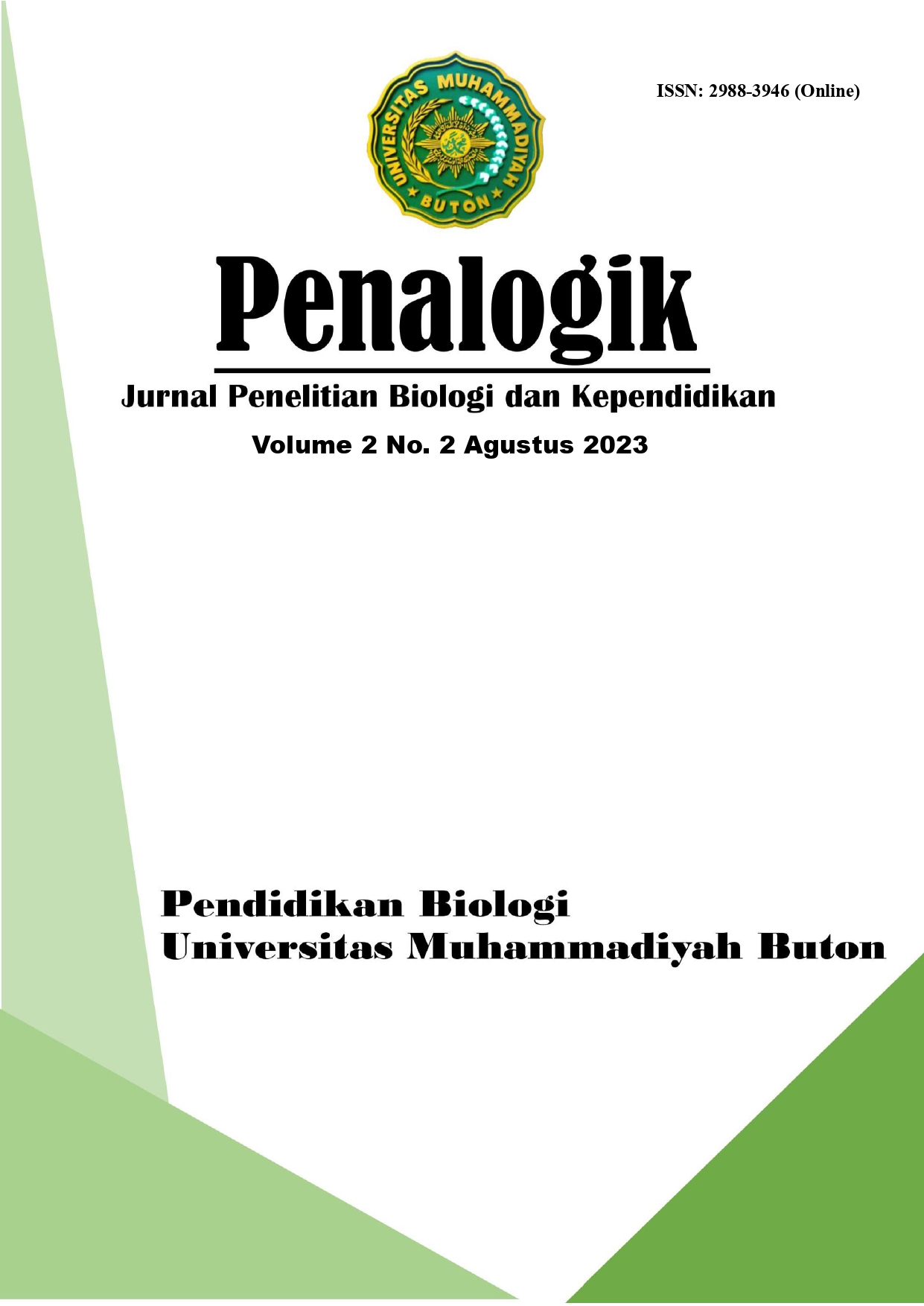Studi Etnobotani Rotan di Desa Tuangila Kecamatan Kapontori Kabupaten Buton
DOI:
https://doi.org/10.35326/penalogik.v2i2.7630Keywords:
Etnobotani, Rotan, Pemanfaatan Lokal, Konservasi , Desa Tuangila.Abstract
Rotan merupakan salah satu sumber daya hayati yang memiliki nilai ekologis, ekonomis, dan budaya tinggi, khususnya di wilayah pedesaan Indonesia. Penelitian ini bertujuan untuk mengidentifikasi jenis-jenis rotan, mendeskripsikan karakteristik morfologinya, serta menganalisis pola pemanfaatan rotan oleh masyarakat di Desa Tuangila, Kecamatan Kapontori, Kabupaten Buton. Penelitian ini menggunakan pendekatan kualitatif deskriptif dengan metode purposive sampling, yang melibatkan tokoh adat, pengrajin, tukang bangunan, dan masyarakat umum sebagai informan. Teknik pengumpulan data dilakukan melalui observasi, wawancara semi-terstruktur, dan dokumentasi lapangan. Hasil penelitian menunjukkan terdapat enam jenis rotan yang dikenal dan dimanfaatkan secara aktif oleh masyarakat, yaitu Calamus zollingerii, Calamus ornatus, Calamus inops, Calamus sp., Calamus caesius, dan Daemonorops robusta. Masing-masing jenis memiliki ciri morfologi yang khas, terutama pada batang, daun, dan buahnya. Pemanfaatan rotan mencakup empat kategori utama, yaitu sebagai bahan pangan (sayur olombe), tali-temali, bahan bangunan, dan kerajinan anyaman seperti keranjang, pemukul kasur, dan bola takraw. Beberapa jenis seperti Calamus inops memiliki nilai ekonomi dan estetika tinggi, namun juga mulai langka akibat tekanan eksploitasi..
Downloads
References
Afentina, McShane, P., & Wright, W. (2020). Ethnobotany, rattan agroforestry, and conservation of ecosystem services in Central Kalimantan, Indonesia. Agroforestry Systems, 94(2), 639–650. https://doi.org/10.1007/s10457-019-00428-x
Agyei-Boakye, I., Fiati, K., Dzivor, D. N., & Lawer, N. J. (2025). Integrating Indigenous Rattan Elements for Functional Sustainability in Contemporary Interior Design. AFRICAN JOURNAL OF APPLIED RESEARCH, 11(2), 663–688. https://doi.org/10.26437/ajar.v11i2.1079
Alamsyah. (2019). Rattan as a Craft Material of Community on the North Coast of Java (Rattan Craft Study in Teluk Wetan Jepara). E3S Web of Conferences, 125, 09018. https://doi.org/10.1051/e3sconf/201912509018
Baitika, B., Dahlan, Z., & Yustian, I. (2018). Morphological Diversity of Rattan on The Three Conservation Areas In South Sumatera. Science and Technology Indonesia, 3(2), 66–72. https://doi.org/10.26554/sti.2018.3.2.66-72
Beltrán-Rodríguez, L., Ortiz-Sánchez, A., Mariano, N. A., Maldonado-Almanza, B., & Reyes-García, V. (2014). Factors affecting ethnobotanical knowledge in a mestizo community of the Sierra de Huautla Biosphere Reserve, Mexico. Journal of Ethnobiology and Ethnomedicine, 10(1), 14. https://doi.org/10.1186/1746-4269-10-14
Campbell, M. J., Edwards, W., Magrach, A., Laurance, S. G., Alamgir, M., Porolak, G., & Laurance, W. F. (2017). Forest edge disturbance increases rattan abundance in tropical rain forest fragments. Scientific Reports, 7(1), 6071. https://doi.org/10.1038/s41598-017-06590-5
Fambayun, R. A., & Kalima, T. (2020). Population of Potential Rattan in Bukit Tiban Protection Forest, Batam, Indonesia. Jurnal Penelitian Kehutanan Wallacea, 9(2), 93. https://doi.org/10.18330/jwallacea.2020.vol9iss2pp93-109
González-Insuasti, M. S., Martorell, C., & Caballero, J. (2008). Factors that influence the intensity of non-agricultural management of plant resources. Agroforestry Systems, 74(1), 1–15. https://doi.org/10.1007/s10457-008-9148-z
Kahindo, J.-M., Nasi, R., Mate, J.-P., & Rigal, C. (2015). Can we go beyond timber and manage for both timber and non-timber forest products? The case of rattans near Kisangani, DR Congo. African Journal of Ecology, 53(3), 331–338. https://doi.org/10.1111/aje.12187
Latifah, S., Yonariza, Purwanto, Codilan, A., Darwo, Syahputra, O. H., & Rambe, A. N. A. (2024). Study of the types and feasibility of the rattan industry for the sustainability of non-timber forest products in North Sumatra. IOP Conference Series: Earth and Environmental Science, 1315(1), 012069. https://doi.org/10.1088/1755-1315/1315/1/012069
Rosero-Toro, J. H., Romero-Duque, L. P., Santos-Fita, D., & Ruan-Soto, F. (2018). Cultural significance of the flora of a tropical dry forest in the Doche vereda (Villavieja, Huila, Colombia). Journal of Ethnobiology and Ethnomedicine, 14(1), 22. https://doi.org/10.1186/s13002-018-0220-0
Schreer, V. (2016). Learning Knowledge About Rattan (Calamoideae arecaceae) and Its Uses Amongst Ngaju Dayak in Indonesian Borneo. Journal of Ethnobiology, 36(1), 125–146. https://doi.org/10.2993/0278-0771-36.1.125
Watanabe, N. M., & Suzuki, E. (2008). Species diversity, abundance, and vertical size structure of rattans in Borneo and Java. Biodiversity and Conservation, 17(3), 523–538. https://doi.org/10.1007/s10531-007-9268-1





